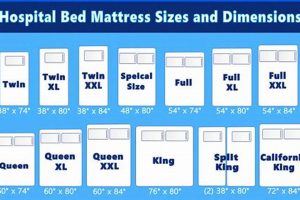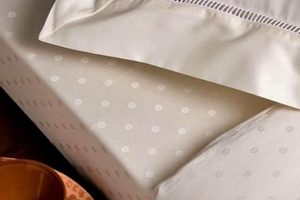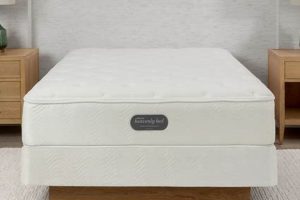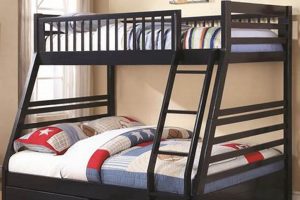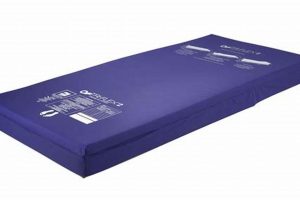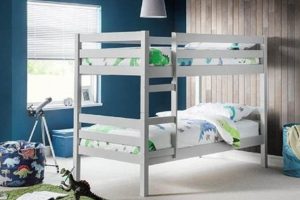A sleeping surface specifically engineered for use within a vertically storable bed frame represents a unique segment of bedding products. These units are often designed with features that accommodate the folding and storage mechanisms inherent in such space-saving furniture. Consider, for example, a scenario where a resident of a small apartment requires a bed for occasional guests; the sleeping platform in that instance would likely be designed for both comfort and ease of storage.
The significance of a properly matched sleeping surface to a vertically storable bed frame resides in maximizing space efficiency and ensuring user comfort. Historically, these frames often utilized thinner, less supportive sleeping surfaces. However, advancements in materials and design have led to improved support and comfort levels, making these options a viable solution for everyday use in compact living spaces. Their benefits extend to multi-purpose rooms, allowing for flexible use of space without sacrificing sleeping comfort.
The subsequent sections will delve into the considerations involved in selecting an appropriate sleeping platform for use with a vertically storable bed frame, focusing on factors such as thickness, materials, weight, and compatibility with various frame mechanisms. Furthermore, the discussion will explore the durability aspects and maintenance requirements associated with prolonged use within a space-saving bed system.
Selecting the Ideal Sleeping Platform for Vertically Storable Bed Frames
Choosing an appropriate sleeping platform for a vertically storable bed frame requires careful consideration of various factors. The following tips offer guidance in navigating this selection process to ensure both comfort and functionality.
Tip 1: Prioritize Thickness Compatibility: Verify that the selected sleeping surface’s thickness adheres to the specifications outlined by the bed frame manufacturer. Exceeding the maximum allowable thickness can impede the frame’s ability to close and lock securely, potentially causing damage to the mechanism or posing a safety hazard.
Tip 2: Assess Weight Considerations: The weight of the sleeping surface should align with the frame’s weight capacity. An excessively heavy sleeping platform can strain the lifting mechanism, reducing its lifespan and increasing the effort required to operate the bed.
Tip 3: Evaluate Material Durability: Opt for materials known for their resilience and ability to withstand repeated compression and folding. High-density foam, latex, and innerspring systems with reinforced edges are generally more durable options for vertically storable bed frames.
Tip 4: Consider Breathability and Temperature Regulation: Select materials that promote airflow and dissipate heat, especially if the sleeping surface is intended for regular use. Memory foam, while comfortable, can retain heat; therefore, consider incorporating cooling gel or breathable covers.
Tip 5: Research Folding Capabilities: Some sleeping surfaces are more amenable to folding than others. Avoid overly stiff or rigid options that may crease or become damaged when stored vertically. Flexible materials that conform to the frame’s curvature are preferred.
Tip 6: Confirm Locking Mechanism Clearance: Ensure that the selected sleeping surface does not obstruct the bed frame’s locking mechanism when in the upright, stored position. Obstructions can compromise the security and stability of the stowed bed.
Tip 7: Inquire About Warranty Coverage: Review the warranty terms provided by both the bed frame and sleeping surface manufacturers. Pay close attention to any exclusions or limitations that may apply when using the sleeping platform with a vertically storable frame.
These guidelines aim to assist in the selection of a sleeping surface that optimizes the functionality and longevity of a vertically storable bed frame. Careful consideration of these factors will contribute to a more comfortable and efficient utilization of space.
The subsequent discussion will address specific maintenance strategies and best practices for prolonging the life of the selected sleeping platform within a vertically storable bed system.
1. Thickness
Thickness constitutes a critical parameter when selecting a sleeping surface for integration with a vertically storable bed frame. It directly influences the functionality, aesthetics, and overall user experience of the wall bed system. Imprecise thickness selection can lead to mechanical complications, aesthetic compromises, and diminished sleeping comfort.
- Mechanism Compatibility
Excessive sleeping surface thickness can impede the proper operation of the wall bed’s folding mechanism. The frame may fail to close completely, or the locking mechanism may not engage securely. This can result in damage to the frame, increased wear and tear on moving parts, and potential safety hazards due to insecure closure.
- Enclosure Aesthetics
The thickness of the sleeping surface contributes significantly to the visual profile of the stowed wall bed. A sleeping platform that is too thick can protrude excessively from the cabinet or enclosure, creating an unsightly appearance and potentially interfering with the surrounding environment. Conversely, an overly thin sleeping surface might not fully conceal the internal frame, resulting in an incomplete or unfinished look.
- Comfort and Support
While thickness alone does not guarantee comfort, it plays a role in the overall support provided by the sleeping surface. Insufficient thickness may result in inadequate support for the user’s body, leading to discomfort and potential musculoskeletal issues. Conversely, excessive thickness without proper internal support structures can result in a surface that feels overly firm and unyielding.
- Weight Considerations
As the thickness of a sleeping surface increases, so does its overall weight. This added weight can strain the lifting mechanism of the wall bed frame, potentially reducing its lifespan and increasing the effort required to raise and lower the bed. Selecting a sleeping surface that is both appropriately thick and constructed of lightweight materials is crucial for optimal performance.
Therefore, the selection of an appropriately dimensioned sleeping platform for a vertically storable bed frame is not merely a matter of preference but a critical engineering consideration. Careful adherence to manufacturer specifications and a thorough understanding of the interplay between thickness, functionality, and user comfort are essential for successful integration and long-term satisfaction with the wall bed system.
2. Weight
The weight of a sleeping platform intended for use within a vertically storable bed frame represents a critical design parameter, directly influenci
ng the operational efficiency, longevity, and safety of the overall system. Precise consideration of weight is paramount to prevent mechanical strain and ensure ease of use.
- Lifting Mechanism Strain
Excessive sleeping surface weight places undue stress on the lifting mechanism of the wall bed. Over time, this strain can lead to accelerated wear and tear on the springs, pistons, or other components responsible for raising and lowering the bed. This reduced lifespan necessitates more frequent repairs or replacements, increasing the long-term cost of ownership. For example, a sleeping platform exceeding the manufacturer’s specified weight limit by even a small margin can significantly shorten the lifespan of a gas-piston-assisted lifting mechanism.
- Operational Force Requirements
Heavier sleeping surfaces demand greater force to maneuver the bed between its upright, stowed position and its horizontal, deployed position. This increased force requirement can make the bed difficult to operate, particularly for individuals with limited strength or mobility. A lightweight option, conversely, allows for smoother and easier transitions, enhancing user convenience and accessibility. Consider the scenario of an elderly individual struggling to lower a heavy sleeping platform; the strain could lead to discomfort or even injury.
- Structural Integrity of the Frame
The weight of the sleeping platform contributes to the overall load borne by the wall bed frame. An excessively heavy sleeping surface can compromise the structural integrity of the frame, potentially leading to warping, bending, or even failure of critical support members. This risk is particularly acute in wall bed frames constructed from less robust materials or featuring intricate designs. For instance, a frame made from particleboard is more susceptible to weight-induced damage than one constructed from solid hardwood.
- Secure Latching and Locking
An overloaded sleeping surface can hinder the proper engagement of the wall bed’s latching and locking mechanisms. The increased weight may prevent the frame from fully closing or from securely locking in the upright position, posing a safety hazard. A partially closed or unlocked bed can unexpectedly descend, potentially causing injury or damage to surrounding objects. Therefore, ensuring that the sleeping platform’s weight remains within the specified limits is crucial for maintaining the safety and security of the wall bed system.
In summary, careful attention to the weight of the chosen sleeping platform is crucial for preserving the mechanical integrity, operational ease, and safety of a vertically storable bed frame. Failure to adhere to weight restrictions can result in a cascade of negative consequences, ranging from increased maintenance costs to potential personal injury.
3. Foldability
Foldability, in the context of a sleeping surface designed for a vertically storable bed frame, represents a critical performance attribute dictating the bed’s operational efficiency and longevity. The ability of the mattress to withstand repeated folding and unfolding cycles without significant degradation directly impacts the ease of use and the lifespan of the entire system. A lack of sufficient foldability can manifest as creasing, material fatigue, and ultimately, a compromised sleeping surface. Consider a scenario where a rigid, innerspring mattress is repeatedly folded within a wall bed frame; the springs may become distorted, leading to uneven support and reduced comfort. The practical significance of understanding foldability lies in selecting materials and construction methods that accommodate the unique stresses imposed by the wall bed mechanism.
The design and material selection of the sleeping platform are paramount in achieving optimal foldability. Foam-based mattresses, particularly those incorporating memory foam or latex, generally exhibit superior foldability compared to traditional innerspring models. The inherent flexibility of these materials allows them to conform to the contours of the folded bed without permanent deformation. Furthermore, mattress manufacturers often employ specialized construction techniques, such as segmented cores or hinged designs, to enhance foldability and minimize stress concentration. For example, some sleeping platforms utilize a series of vertical cuts or grooves on the underside to facilitate bending along specific axes, effectively creating flexible zones that prevent creasing. This attention to detail in design and manufacturing directly translates to improved performance and durability within the vertically storable bed system.
In conclusion, foldability is an indispensable characteristic of a wall bed mattress, influencing both the user experience and the long-term viability of the product. Choosing a sleeping surface with adequate foldability, achieved through appropriate material selection and design considerations, mitigates the risks of damage, enhances ease of use, and ultimately extends the lifespan of the entire wall bed system. The primary challenge lies in balancing foldability with other desirable attributes such as support and comfort. The understanding of these factors ensures the functional value of this innovative, space-saving sleeping solution.
4. Support
Adequate support in a sleeping surface designed for a vertically storable bed frame directly influences user comfort, spinal alignment, and long-term physical well-being. Insufficient support can lead to discomfort, exacerbate existing musculoskeletal issues, and negatively impact sleep quality. For instance, a sleeping platform lacking adequate support may cause the spine to misalign during sleep, resulting in back pain, neck stiffness, and reduced sleep efficiency. The relationship between support and sleeping surface construction is therefore paramount; the materials and design must work in concert to provide a stable and conforming surface that accommodates the sleeper’s individual needs.
The level of support required varies based on individual factors such as body weight, sleeping position, and personal preferences. Heavier individuals generally require firmer surfaces to prevent excessive sinking and maintain spinal alignment. Side sleepers often benefit from sleeping surfaces with enhanced pressure relief in the shoulder and hip areas, while back sleepers typically require support that promotes proper lumbar curvature. Manufacturers address these varying needs by incorporating different materials and construction techniques into their products. High-density foams, individually wrapped coils, and layered constructions are commonly used to provide targeted support and pressure relief. The selection of a sleeping platform with appropriate support characteristics is therefore a critical step in ensuring a comfortable and healthy sleep experience.
In summary, the support provided by a sleeping surface within a vertically storable bed frame is a fundamental determinant of user satisfaction and long-term physical health. Selecting a sleeping surface with adequate support characteristics, tailored to individual needs and preferences, mitigates the risks of discomfort, musculoskeletal issues, and poor sleep quality. The challenge lies in balancing support with other critical attributes, such as foldability and weight, to create a well-rounded sleeping solution. The ultimate goal is to provide a space-saving sleeping platform that promotes restf
ul and restorative sleep.
5. Durability
Durability, in the context of a sleeping surface designed for a vertically storable bed frame, signifies its capacity to withstand repeated use, folding cycles, and storage conditions without significant degradation of performance or structural integrity. The inherent space-saving nature of these beds necessitates frequent manipulation, placing considerable stress on the sleeping platform. Therefore, durability is not merely a desirable attribute, but a crucial determinant of the long-term value and utility of the wall bed system.
- Material Composition and Resistance to Fatigue
The inherent properties of materials used in construction dictate a sleeping surface’s resistance to fatigue, a phenomenon characterized by progressive and permanent structural damage occurring under cyclic loading. High-density foams, latex, and tempered steel coils offer superior resistance to compression set and distortion compared to lower-quality alternatives. For example, a sleeping platform incorporating high-density memory foam is less likely to develop permanent indentations or sagging over time, even with daily use and frequent folding. The choice of materials directly translates into the lifespan and sustained performance of the product.
- Seam Strength and Edge Support
The seams and edges of a sleeping surface are particularly vulnerable to wear and tear, especially within a wall bed system where these areas are subjected to repeated bending and compression. Reinforced seams and robust edge support structures are essential for preventing premature failure. For instance, a sleeping platform with double-stitched seams and a high-density foam encasement around its perimeter is less likely to develop fraying or edge collapse over time, maintaining its structural integrity and aesthetic appeal. These reinforcements contribute significantly to the overall durability of the sleeping surface.
- Resistance to Environmental Factors
Sleeping surfaces within wall beds are often stored in enclosed spaces, which can expose them to fluctuations in temperature and humidity. Materials that are resistant to moisture, mold, and mildew are crucial for maintaining hygiene and preventing premature degradation. For example, a sleeping platform with a breathable, moisture-wicking cover is less likely to harbor allergens or develop unpleasant odors, contributing to a healthier and more durable sleeping environment. The ability to withstand environmental stressors is a key factor in prolonging the lifespan of the sleeping surface.
- Construction Techniques and Manufacturing Quality
The overall durability of a sleeping surface is significantly influenced by the quality of the manufacturing processes and the precision of the construction techniques employed. Tight tolerances, secure bonding, and consistent material distribution contribute to a more robust and resilient product. For instance, a sleeping platform constructed with meticulous attention to detail and subjected to rigorous quality control measures is less likely to exhibit premature failure due to manufacturing defects. The investment in high-quality manufacturing processes directly translates into enhanced durability and long-term performance.
In conclusion, the durability of a sleeping surface intended for use within a vertically storable bed frame is a multifaceted characteristic encompassing material selection, construction techniques, and resistance to environmental factors. By carefully considering these aspects, consumers can ensure that their sleeping platform maintains its structural integrity, comfort, and hygienic properties over an extended period, maximizing the value and utility of their wall bed system. The interplay of these facets defines the sleeping platforms lasting resilience.
6. Breathability
The breathability of a sleeping surface within a vertically storable bed frame is a critical factor influencing user comfort and long-term hygiene. Limited air circulation can lead to heat retention and moisture accumulation, creating an unfavorable sleep environment. This becomes particularly relevant in the context of vertically storable beds, where the encasement of the sleeping surface during storage can exacerbate these issues.
- Material Composition and Airflow
The inherent properties of materials used in the construction of the sleeping platform significantly impact its breathability. Open-cell foams, such as latex or certain types of memory foam, allow for greater airflow compared to closed-cell alternatives. Innerspring systems, by their design, typically offer better ventilation due to the open spaces between the coils. For example, a latex sleeping surface, with its naturally porous structure, promotes continuous airflow, dissipating heat and moisture more effectively than a traditional memory foam option.
- Cover Fabric and Moisture Wicking
The fabric used for the sleeping surface cover plays a crucial role in managing moisture and promoting breathability. Natural fibers, such as cotton or bamboo, are known for their moisture-wicking properties, drawing perspiration away from the body and allowing it to evaporate. Synthetic fabrics, while often more durable, may restrict airflow and trap moisture, potentially leading to discomfort. A sleeping surface with a cover made from a blend of natural and synthetic fibers can offer a balance of breathability and durability.
- Ventilation Design and Air Channels
Some sleeping surface manufacturers incorporate specific design elements to enhance ventilation. These may include air channels within the foam core or perforated layers that promote airflow. These features are particularly beneficial in sleeping platforms designed for vertically storable beds, where the lack of ambient air circulation can exacerbate heat and moisture buildup. Consider a sleeping surface with strategically placed ventilation channels that allow for consistent airflow, even when the bed is in the stowed position.
- Impact of Storage Conditions on Breathability
The conditions under which a vertically storable bed is stored can significantly impact the breathability of the sleeping surface. Enclosed spaces with poor ventilation can trap heat and moisture, creating an environment conducive to mold and mildew growth. Regular airing of the sleeping platform, when possible, can help to mitigate these issues. Additionally, the use of moisture-absorbing materials, such as desiccant packs, within the storage compartment can help to maintain a dry and hygienic environment.
In conclusion, breathability is a critical consideration when selecting a sleeping surface for a vertically storable bed frame. The material composition, cover fabric, ventilation design, and storage conditions all contribute to the overall breathability of the sleeping platform. Prioritizing breathability helps to ensure a comfortable, hygienic, and long-lasting sleep environment, maximizing the value and utility of the wall bed system.
Frequently Asked Questions
This section addresses common inquiries regarding the selection and maintenance of sleeping surfaces designed for vertically storable beds. The intent is to provide clarity on key considerations and dispel potential misconceptions.
Question 1: What is the rec
ommended thickness for a sleeping platform used in a vertically storable bed frame?
The optimal thickness varies depending on the specific bed frame model. Refer to the manufacturer’s specifications for precise guidelines. Exceeding the recommended thickness can impede proper closure and compromise the frame’s locking mechanism.
Question 2: Does the weight of the sleeping surface affect the operation of a wall bed?
Yes, the weight of the sleeping surface significantly impacts the lifting mechanism’s performance. An excessively heavy option can strain the mechanism, reducing its lifespan and making operation more difficult. Adhering to the manufacturer’s weight limits is crucial.
Question 3: What materials are best suited for a sleeping surface used in a vertically storable bed frame?
Durable and flexible materials are preferred. High-density foams, latex, and innerspring systems with reinforced edges offer a balance of comfort and resilience. Avoid overly rigid options that may crease or become damaged when folded.
Question 4: How should a vertically storable bed sleeping surface be maintained?
Regularly vacuum the surface to remove dust and debris. Address spills promptly to prevent staining and moisture damage. Rotate the surface periodically to promote even wear. Consult the manufacturer’s instructions for specific cleaning and care recommendations.
Question 5: Can any type of sleeping surface be used in a vertically storable bed frame?
No, not all options are suitable. Factors such as thickness, weight, and foldability must be considered. Avoid using overly thick, heavy, or rigid sleeping surfaces that are not specifically designed for use with vertically storable bed frames.
Question 6: How does breathability affect the choice of a sleeping surface for a wall bed?
Breathability is essential for maintaining a comfortable and hygienic sleep environment. Opt for materials that promote airflow and dissipate heat to prevent moisture buildup and reduce the risk of mold or mildew growth. Consider using a breathable sleeping surface cover.
These FAQs provide essential information for selecting and maintaining a sleeping surface for a vertically storable bed. Careful consideration of these factors will contribute to the longevity and performance of the overall system.
The following section will delve into the economic considerations associated with the ownership and maintenance of wall bed systems.
Conclusion
This exploration has detailed the critical considerations involved in selecting a sleeping surface for a vertically storable bed frame. Parameters such as thickness, weight, foldability, support, durability, and breathability directly influence the functionality, longevity, and user satisfaction derived from such systems. The prudent selection of a wall bed mattress involves careful assessment of these factors to ensure compatibility with the specific frame and alignment with individual needs.
The integration of a properly specified sleeping surface represents a long-term investment in space optimization and sleep quality. Ongoing advancements in materials and design suggest future refinements in vertically storable bed systems, further enhancing their practicality and appeal. Prioritizing informed decision-making regarding component selection will maximize the return on investment and contribute to the sustained utility of these space-saving solutions.


